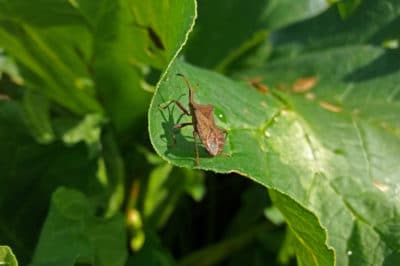Minor Pests Do Minimal Damage
Aphids, spider mites, and stink bugs may attack the squash plants doing minimal damage. Some of these insects can carry disease to the plant but rarely kill it. The best non-toxic solution for these pests is simply to remove and kill them.
Squash Vine Borer-A Major Concern
The squash vine borer begins its life cycle as a larva or pupa in a cocoon overwintering in the garden. A small metallic green moth emerges from the cocoon in early summer. Black and orange hairs rim the hind legs of the moth. The abdomen also has similar coloring. The moth lays eggs on the stems of the squash plants.
After the eggs hatch, the small whitish larvae enter the squash plant stem, beginning their damage. The tunneling evidence is a sawdust-like waste on the stems. If the tunneling is not soon stopped the stem will dry up, killing the plant.
Squash Vine Borer Egg Laying Prevention
Preventing the moth from laying the eggs in the first place is the best remedy for the squash vine borer. Very early in the squash plant’s development, a gardener can place pantyhose around the stem of the plant. Follow these steps to create the protective barrier that prevents the moth from laying eggs on the young plant:
- Cut a 4 inch to 6 inch (10.2 cm to 15.2 cm) long circular piece of pantyhose.
- Carefully place the pantyhose around lower stems of young plant.
- Place some of pantyhose below soil surface.
- Secure the pantyhose in place.
Removal of Squash Vine Borer
If the protective barrier fails, another way to correct this pest problem is to remove the borer. Simply, locate the borer, make a small lengthwise cut, pull the borer out, and destroy borer. The final step is to cover the cut area with soil to encourage new root development. The plant should survive.
Squash Bugs-A Major Concern
Squash bugs overwinter in the garden. The adults usually lay their yellowish brown to brick red in color eggs under the leaves of a young squash plant. Young squash bugs are whitish to greenish gray, with black legs, but soon grow into 5/8 inch (1.6 cm) long brownish black adults.
Squash Bug Remedies
Neem oil extract, peppermint oil, or diatomaceous earth can be used to control or kill squash bugs. An observant gardener can also locate the eggs and tear off the portion of the leaf containing the eggs. Another simple method is just trapping the bugs then killing them.
